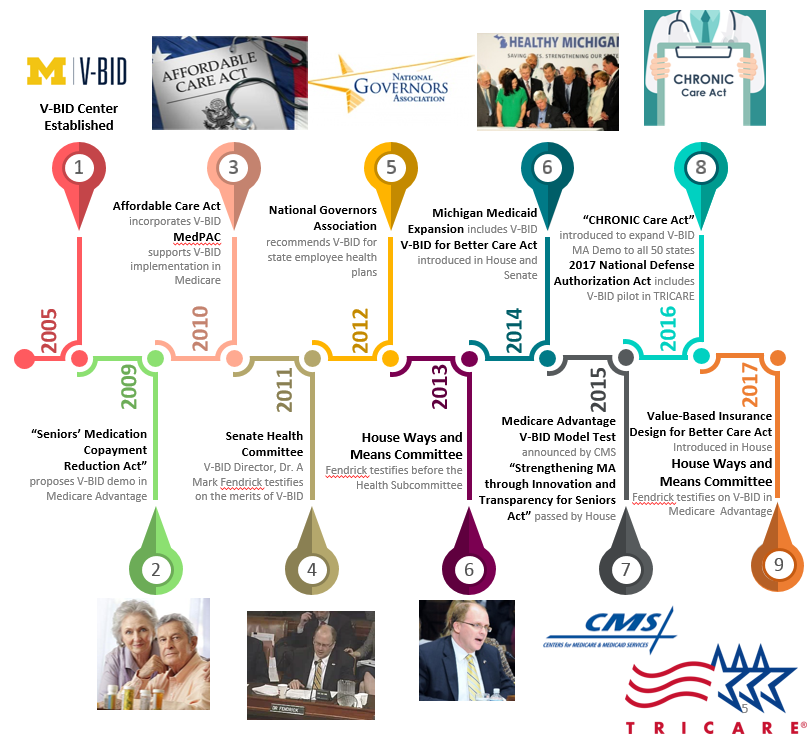The University of Michigan Center for Value-Based Insurance Design (V-BID Center) is an advocate for development, implementation, and evaluation of clinically nuanced health benefit plans and payment models. Since its inception in 2005, the V-BID Center has been actively engaged in understanding the impact of consumer engagement initiatives on health outcomes. Through collaboration with employers, consumer advocates, health plans, policy leaders, and academics, the Center hopes to improve clinical outcomes and enhance economic efficiency of the U.S. health care system.
Director’s Message
As I reflect back on the past two years, the Center for Value-Based Insurance Design (V-BID) has experienced many challenges and triumphs. With that, I am excited to see the progress we have made in shifting the U.S. health care system from one of volume to one of value, and am confident that our progress will be sustained.
The year 2015 was particularly eventful for V-BID as the Center for Medicare and Medicaid Services (CMS) approved the adoption of V-BID concepts in nine Medicare Advantage (MA) plans across three states. The five-year demonstration launched in January 2017, and will emphasize assessing the utility of reducing Medicare beneficiary cost-sharing for identified chronic conditions.
Entering 2017, the importance of our work become increasingly relevant, as healthcare reform discussions and more specifically, reducing healthcare expenditures, became a centerpiece of the new Presidential administration. Unfortunately, the necessity of improving consumer engagement in health has come second to devising alternative methods of payment. This misalignment of interests is one of the leading causes of poor health outcomes in the United States, but it is also our driving force in advocating for the alignment of payment reform and consumer engagement initiatives. The coming together of healthcare stakeholders from across the nation to confront the growing problem of underinsurance and tackle the pervasive use of low-value care will create opportunities for focused discussions on improving quality, enhancing patient experience, and containing healthcare costs.
In the coming year, as the debate over drug pricing emerges as a front runner in healthcare reform discussions, it will be important for the V-BID Center to push for the incorporation of clinical nuance in proposed reform strategies. Be it pharmaceutical companies, insurance design, or healthcare providers, the VBID Center will maintain its role in advocating for the furthering of discussions on aligning patient interests and payment methods.
Thank you for being part of the V-BID movement. We look forward to creating a healthier tomorrow with all of you.
A. Mark Fendrick, M.D.
Director
Value-Based Insurance Design
From Principle to Policy
Lowering health care expenditures and ensuring access to high quality medical care for all Americans is a health policy priority. With its clinically nuanced approach to policy reform, Value-Based Insurance Design (V-BID) principles have gained rare bipartisan and broad multi-stakeholder support. Starting in 2010 with the passage of the Affordable Care Act and its requirement that health insurance plans provide coverage for certain high-value, evidence-based preventive services without a co-pay and pre-deductible, V-BID principles have figured prominently in a wide range of policy areas. Even as we look back on all that the V-BID Center has achieved in the last few years, we look forward to more positive, V-BID influenced changes in health policy in the future.
HSA-Eligible High-Deductible Health Plans
High-deductible health plans paired with a tax-free health savings account (HSA-HDHP) have been rising in popularity since 2006. Approximately 20 million Americans were enrolled in some form of an HDHP as of 2016, representing a six-fold increase in enrollment in just ten years. Because President Donald Trump and Congressional Republicans have focused on HSA-HDHPs as a way to encourage consumer engagement and control ballooning health costs, the trend in HSA-HDHP enrollment is likely to continue.
V-BID in HSA-HDHPs
Though Internal Revenue Code Section 223 (c)(2)(C) outlines a “safe harbor” in which HSA-eligible HDHPs can cover certain, evidence-based preventive services prior to satisfaction of the plan deductible, the safe harbor excludes any preventive services used to treat an existing illness, injury, or condition. This leaves enrollees with chronic conditions financially responsible for essential care until they have met their plan deductible. The resulting reduction in utilization of care leads to poorer health outcomes and potentially higher societal costs. This restricted safe harbor provides an opportunity for the implementation of V-BID principles. Expanding the safe harbor to include the high-value preventive services used to treat chronic and existing illnesses so enrollees can get the care they need to prevent the development of further complications. The expanded safe harbor is the cornerstone of our High Value Health Plan, a value-based alternative to HDHPs.
V-BID Center Progress
The V-BID Center has made substantial headway in incorporating value-based principles into HDHPs. In July of 2016, the Access to Better Care Act was introduced in the House of Representatives by Representatives Diane Black (R-TN) and Earl Blumenauer (D-OR). This bipartisan bill amends the IRS safe harbor to include preventive services used to treat existing illnesses, injuries, or conditions. In January of 2017, Dr. A. Mark Fendrick and Dr. Michael Chernew published an editorial in the Journal of the American Medical Association promoting the use of smarter deductibles to encourage consumer engagement and mitigate cost-related nonadherence.
Most recently and notably, President Donald Trump signed an Executive Order in July 2017 that updated the IRS preventive care safe harbor to “include services or benefits, including medications, intended to prevent chronic disease progression or complications.” The signing of this executive order was a monumental victory for the V-BID Center in their promotion of better health for all Americans.
V-BID in Medicare Advantage
Ensuring Access to High Quality Medical Care
Medicare Advantage plans are playing an increasingly larger role in the Medicare program as the portion of Medicare beneficiaries who are enrolled in MA have increased to 33% in 2017 and is projected to reach 41% in 2027. However, out-of-pocket costs for MA beneficiaries continue to rise and enrollees are faced with higher cost sharing, often resulting in patients forgoing essential medical care due to financial barriers. There is robust support to suggest that this decreased use of evidence-based services leads to reductions in care quality, sub-optimal patient outcomes, and, in certain instances, increases in overall health care spending.
V-BID in MA
Incorporation of V-BID principles into MA Plans has garnered multi-stakeholder and bipartisan political support. V-BID can encourage the utilization of high-value providers and services and limit the use of services that are of potentially low-value, thus helping MA plans improve health and quality, enhance consumer engagement, and reduce healthcare costs.
MA V-BID Model Test
As the debate over rising healthcare expenditures continue to evolve, policymakers have begun to explore consumer engagement initiatives, in addition to provider payment reforms, as a possible solution to curbing rising costs. One way policymakers are making this change is through the Centers for Medicare and Medicaid Services’ MA V-BID Model Test.
Launched in January 2017, the five-year demo model permitted nine MA plans across Massachusetts, Indiana, and Pennsylvania to vary benefit designs for enrollees with specified clinical conditions (diabetes mellitus (DM), congestive heart failure (CHF), chronic obstructive pulmonary disease (COPD), past stroke, hypertension, coronary artery disease, and mood disorders). Actuarial modeling of MA V-BID programs for DM, COPD, CHF demonstrates that consumer out-of-pocket costs are reduced in all 3 conditions, plan costs increase slightly in the short term for certain conditions (DM and COPD), and plan savings result for CHF. From societal perspective, net savings resulted in the COPD and CHF programs while the DM program was close to cost neutral.
What’s Next?
In June 2017, Dr. Fendrick testified before the House Ways and Means Subcommittee on Health during their Medicare Advantage Hearing on Promoting Integrated and Coordinated Care for Medicare Beneficiaries. There, Dr. Fendrick advocated for the passing of the CHRONIC Care Act of 2017, a bipartisan bill that specifically calls for the expansion of the MA V-BID demonstration to all 50 states. Expansion of the MA V-BID demo will improve the quality of MA plans and the health of Medicare beneficiaries.
Precision Medicine Needs Precision Benefit Design
Precision medicine— the integration of molecular science into the clinical care of an individual patient—has spurred efforts to develop targeted preventive strategies and disease-specific therapies.
TRICARE and Defense Health Care Reform
The TRICARE program is a military health insurance plan serving those currently enrolled in U.S. Armed Forces as well as retirees and their family members. Like most U.S. health plans, the TRICARE program currently implements consumer cost-sharing in a “one-size-fits all” manner with beneficiaries paying the same amount for every diagnostic test, prescription drug, and doctor visit. As healthcare costs continue to rise, evidence has shown that these increases in consumer cost-sharing lead to decreases in both non-essential and essential care.
The implementation of Value-Based Insurance Design (V-BID) in the TRICARE program reallocates medical spending by encouraging members to shift from a volume-driven to a value-based military health delivery system. V-BID’s tenet of clinical nuance lowers or removes financial barriers to essential, high-value clinical services by encouraging beneficiaries to use more high-value services while at the same time discouraging the use of low-value services.
V-BID TRICARE Pilot
In February 2016, V-BID Center Director Dr. Mark Fendrick was invited by Senator John McCain to testify before the U.S. Senate Committee on Armed Services where he spoke on the importance of aligning TRICARE beneficiaries’ out-of-pocket costs with the clinical value of services.
With growing bipartisan support for the expanded role of V-BID in public and private payers, former President Obama signed the 2017 National Defense Authorization Act on December 23, 2016 which called for a pilot program to demonstrate and test the feasibility of incorporating V-BID into the TRICARE program. Beginning in 2018, this pilot will evaluate how reducing or eliminating cost-sharing for certain high-value medications and services affects (I) adherence to medications, (II) quality measures, (III) health outcomes, and (IV) beneficiary experience. By “reducing copayments …for targeted populations of covered beneficiaries in the receipt of high-value medications and services and the use of high-value providers,” the pilot aims to improve health outcomes and enhance the experience of care for the over 9.3 million U.S. Armed Forces military personnel, military retirees, and their dependents currently enrolled in the TRICARE program.
Student Engagement
Developming the Next Generation of Healthcare Leaders
Lowering health care expenditures and ensuring access to high quality medical care for all Americans is a health policy priority. With its clinically nuanced approach to policy reform, Value-Based Insurance Design (V-BID) principles have gained rare bipartisan and broad multi-stakeholder support. Starting in 2010 with the passage of the Affordable Care Act and its requirement that health insurance plans provide coverage for certain high-value, evidence-based preventive services without a co-pay and pre-deductible, V-BID principles have figured prominently in a wide range of policy areas. Even as we look back on all that the V-BID Center has achieved in the last few years, we look forward to more positive, V-BID influenced changes in health policy in the future.





